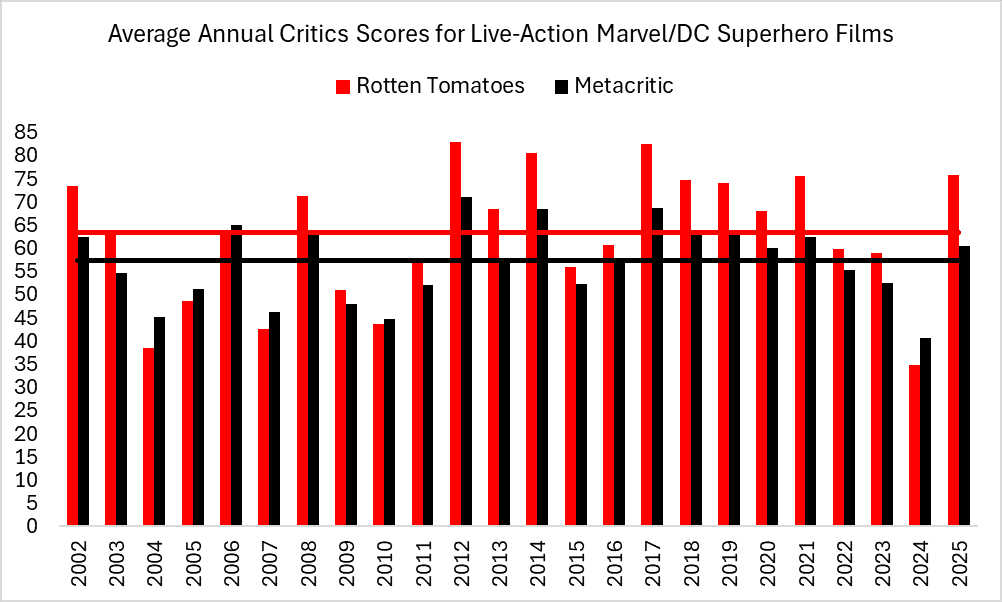The dust hasn’t settled on Superman and The Fantastic Four: First Steps, the dueling DC and Marvel tentpoles that launched a new cinematic universe and MCU phase, respectively, this month. Both blockbusters have many more millions to add to their global box office totals. But, before August, Hollywood has already wrapped its big-screen superhero output for 2025. With four new films from Marvel and DC in the can, the biggest superhero moviemakers have embarked on a big-screen hiatus of almost a year, which will last until the scheduled debuts of Supergirl and Spider-Man: Brand New Day next summer.
All of which makes this a fitting time for the latest installment of a favorite pop culture pastime: assessing the state of superhero movies.
After years of “superhero fatigue” fretting, the genre bottomed out in 2024. Madame Web, Venom: The Last Dance, and Kraven the Hunter brought an appropriately ignoble end to Sony’s live-action Spider-Man Universe. Joker: Folie à Deux was a widely panned, money-losing, mystifying follow-up to Todd Phillips’s 2019 Oscar winner. DC Studios was idle following the last gasp of the DC Extended Universe, Aquaman and the Lost Kingdom, which came out in the closing days of 2023. And while last year’s lone MCU movie, Deadpool & Wolverine, found favor with theatergoers, who propelled it to $1.3 billion in ticket sales, the sequel’s incessant recycling, coupled with Robert Downey Jr.’s return to the Marvel franchise fold, cemented the perception that Kevin Feige’s fiefdom was out of new ideas.
Thus, the pressure was on for this year’s big-screen slate of Captain America: Brave New World, Thunderbolts*, Superman, and The Fantastic Four—particularly the last two, which would in turn inaugurate the new DC Universe and the MCU’s Phase 6. As my colleague Daniel Chin wrote in February, “These four films represent an important test for both studios—and their competitors—to gauge where their audiences’ appetites stand and whether it’s time for their parent companies to hit the panic button on their prospective plans.” A second consecutive year of critical and financial flops would endanger DC’s and Marvel’s long-term plans, as well as the long-standing superhero hegemony in Hollywood.
The good news for those suffering from superhero fatigue fatigue is that this quartet—well, the last three releases, really, because Brave New World seemed to deepen the death spiral—has pulled off a collective creative rebound. The chart below shows the average Rotten Tomatoes and Metacritic critics scores for live-action DC and Marvel movies (as classified by Metacritic) dating back to 2002—a pool of 102 movies, or an average of 4.25 per year. The horizontal lines indicate the average ratings over the 24-year period.

The rightmost couple of columns tell a tale of two receptions: the worst of times, and … well, not quite the best of times, but above-average times, at least. Last year’s average Rotten Tomatoes and Metacritic ratings (40.6 and 34.8, respectively) were both easily the lowest in the nearly quarter-century sample. This year’s (75.8 and 60.5, respectively) are the best since 2017 and 2021. Both of those 2025 figures are above the overall averages, and the Rotten Tomatoes score is the fourth highest in the whole span, after 2012, 2017, and 2014.
Although both sites are review aggregators with 100-point scales, they tackle their task differently. The scoring system at Rotten Tomatoes is binary: positive or negative, fresh or rotten. By contrast, Metacritic captures gradations of goodness by assigning a rating to each review and then calculating a weighted average of every review’s ratings. Thus, they answer slightly different questions: Rotten Tomatoes reports what percentage of critics deemed a movie more good than bad, whereas Metacritic reports how good they deemed it. Some superhero movies have similar Rotten Tomatoes and Metacritic ratings: for instance, Superman Returns, which sports a 72 at both sites. Other movies’ respective scores diverge by 20-plus points.
This year’s Superman (which has a 15-point difference between Rotten Tomatoes and Metacritic ratings), Thunderbolts* (20), and First Steps (22) all have far higher Rotten Tomatoes scores than Metacritic scores, suggesting that while critics largely liked them, they didn’t really love them. Hence this year’s robust average rating at Rotten Tomatoes relative to Metacritic. Even at Metacritic, though, this year has been a bit better than average, which represents a significant recovery from the nadir of last year. After a triple bogey, even making par can be a big relief.
Some of this modest bounce back stems simply from addition by subtraction: It doesn’t hurt that Sony stopped making mostly terrible “Spider-Man” movies (sans Spider-Man himself). But for both better and worse, Marvel Studios and DC Studios themselves have also avoided extreme receptions. None of this year’s not-so-fantastic four films placed among the top 20 Marvel and DC films made since 2002, per Rotten Tomatoes or Metacritic. (Thunderbolts*, the best reviewed of the bunch, ranked 22nd and 27th, respectively.) But none of them entered the bottom 20, either. (Brave New World wound up 29th worst and 22nd worst, respectively.) Compared with the lows of last year, unspectacular competence seems like a win.
Movie studios, of course, care more about the bottom line than about the critical consensus. In that area, this year’s movies have been more of a mixed bag. In terms of revenue, Thunderbolts* is one of the lowest-grossing MCU films (especially after adjusting for inflation), which Feige attributed to its characters’ TV origins. Brave New World didn’t do much better, which Feige blamed on the fact that it was “the first [Captain America movie] without Chris Evans.” The creative turmoil and tangled narrative roots can’t have helped: The movie was a quasi-sequel to three old and/or mediocre Marvel movies and shows, 2008’s The Incredible Hulk and 2021’s The Falcon and the Winter Soldier and Eternals.
On the plus side, Superman posted the strongest opening for a solo Superman movie and has raked in more than $500 million worldwide in three-plus weeks, which Feige held up as proof that the genre’s problem is “clearly not superhero fatigue.” First Steps, which launched last weekend, also enjoyed a record opening for a film featuring its eponymous superheroes, coming in just a curly forelock behind Superman’s opening gross. But because superhero blockbusters don’t draw as well in China as they used to—for reasons unrelated to “fatigue”—their international earnings potential isn’t what it once was. On the whole, then, this year has brought more middle-of-the-road results in this respect, too: no flops as disastrous as The Marvels, but no huge hits on the order of Deadpool & Wolverine.
If we had to characterize this year’s big-screen superhero returns in a simplistic, Rotten Tomatoes–style way, we would have to pronounce them fresh, not rotten. The question is whether we’re seeing a lasting course correction or a dead cat bounce. I’d lean toward the former, although (as usual) it may be a bit of both.
For one thing, Superman doesn’t believe in letting cats—or squirrels—die. For another, both DC Studios and Marvel Studios appear to have plans in place to steer clear of the excess and aimlessness that have plagued their recent pasts. Superman is the first salvo in James Gunn’s concerted effort to produce a DC universe as well orchestrated and cohesive as Marvel’s was. In terms of story, Marvel has momentum for the first time in a while. A crew of New Avengers is assembled, Marvel’s First Family has been successfully introduced, and a “reset” to a “singular timeline” is coming, along with two new Avengers movies and the company’s trump card: the X-Men.
On the small screen, results remain highly variable: This year’s Marvel offerings have ranged from Ironheart (whose reviews were, in Metacritic terms, “mixed or average”) to Daredevil: Born Again (“generally favorable”) to Your Friendly Neighborhood Spider-Man (generally, um, more favorable). There are three more Marvel series to come this year, plus DC’s second season of Peacemaker—which will be followed next year by the highly anticipated Lanterns. All in all, though, the superhero assembly lines have slowed, as the movie release calendar shows. The chart below displays a rolling two-year average of the number of live-action DC and Marvel movies released each year, extrapolated to include the four confirmed qualifying films for 2026, plus the two for 2027 (which could be postponed or supplemented).

Critically and financially, these film franchises peaked in the late 2010s, when the ultra-lucrative Avengers: Endgame delivered the climax of the MCU’s Infinity Saga. But the pinnacle for sheer volume came a few years later, as the “fatigue” drumbeat built. The architects of superhero cinema have been vocal about the downsides of that rush to release: “For the first time ever, quantity trumped quality,” Feige admitted this month. A lower quantity doesn’t guarantee higher quality. But it should help the two titans maintain more consistent standards while also making it more likely that the superhero supply doesn’t outstrip audience demand—as long as the urge to evade catastrophe doesn’t stifle the franchises’ originality. Risk-averse storytelling poses potential threats, too.
The it’s so over/we’re so back superhero reaction cycle, in which each movie is derided as a death knell for the genre or hailed as triumphant proof of its life, is tiresome and tends toward hyperbole and recency bias. The reality is more nuanced: a partial superhero recovery, not a complete collapse or a full return to form. As Substacker the Entertainment Strategy Guy concluded in February, just before the beginning of the latest flurry of films, “Superheroes continue to be a bankable genre at the box office, but the 2018 to 2019 time frame represented a peak superheroes won’t easily get back to.”
The creative and financial heyday of superheroes has probably passed, but being a bit past one’s prime doesn’t dictate a swift descent from dominance to obsolescence. There seems to be plenty of life left in big-screen superheroes, who are here for the long haul. But after a boom-and-bust half decade, 2025 has hearkened back to the old normal—and, maybe, established a new normal, too.
